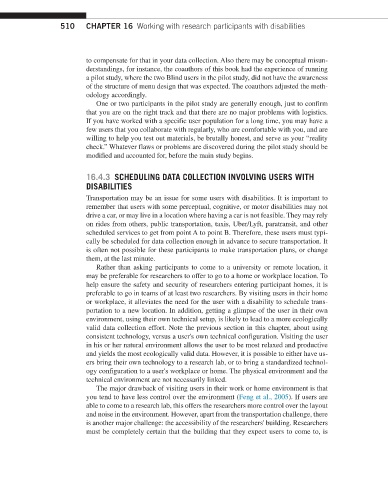Page 517 -
P. 517
510 CHAPTER 16 Working with research participants with disabilities
to compensate for that in your data collection. Also there may be conceptual misun-
derstandings, for instance, the coauthors of this book had the experience of running
a pilot study, where the two Blind users in the pilot study, did not have the awareness
of the structure of menu design that was expected. The coauthors adjusted the meth-
odology accordingly.
One or two participants in the pilot study are generally enough, just to confirm
that you are on the right track and that there are no major problems with logistics.
If you have worked with a specific user population for a long time, you may have a
few users that you collaborate with regularly, who are comfortable with you, and are
willing to help you test out materials, be brutally honest, and serve as your “reality
check.” Whatever flaws or problems are discovered during the pilot study should be
modified and accounted for, before the main study begins.
16.4.3 SCHEDULING DATA COLLECTION INVOLVING USERS WITH
DISABILITIES
Transportation may be an issue for some users with disabilities. It is important to
remember that users with some perceptual, cognitive, or motor disabilities may not
drive a car, or may live in a location where having a car is not feasible. They may rely
on rides from others, public transportation, taxis, Uber/Lyft, paratransit, and other
scheduled services to get from point A to point B. Therefore, these users must typi-
cally be scheduled for data collection enough in advance to secure transportation. It
is often not possible for these participants to make transportation plans, or change
them, at the last minute.
Rather than asking participants to come to a university or remote location, it
may be preferable for researchers to offer to go to a home or workplace location. To
help ensure the safety and security of researchers entering participant homes, it is
preferable to go in teams of at least two researchers. By visiting users in their home
or workplace, it alleviates the need for the user with a disability to schedule trans-
portation to a new location. In addition, getting a glimpse of the user in their own
environment, using their own technical setup, is likely to lead to a more ecologically
valid data collection effort. Note the previous section in this chapter, about using
consistent technology, versus a user's own technical configuration. Visiting the user
in his or her natural environment allows the user to be most relaxed and productive
and yields the most ecologically valid data. However, it is possible to either have us-
ers bring their own technology to a research lab, or to bring a standardized technol-
ogy configuration to a user's workplace or home. The physical environment and the
technical environment are not necessarily linked.
The major drawback of visiting users in their work or home environment is that
you tend to have less control over the environment (Feng et al., 2005). If users are
able to come to a research lab, this offers the researchers more control over the layout
and noise in the environment. However, apart from the transportation challenge, there
is another major challenge: the accessibility of the researchers' building. Researchers
must be completely certain that the building that they expect users to come to, is

